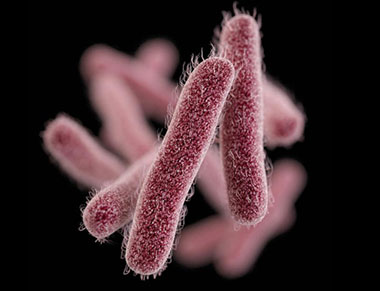
| Jan. 2018 | |||||||||||
| Top stories | |||||||||||
| In the news | |||||||||||
| Photos | |||||||||||
| Contact us | |||||||||||
| Archive | |||||||||||
|
Researchers investigate safety of new technology |
Jan. 25, 2017 --
The State Hygienic Laboratory recently joined seven other state public health labs to study the safety and accuracy of MALDI-TOF Mass Spectrometry in identifying dangerous organisms. Wanda Reiter Kintz, director of the Office of Emergency Preparedness, led the Hygienic Lab team in the national study supported by the Association of Public Health Laboratories (APHL) and the CDC.
 Shigella is one of the bacteria that can be quickly detected using the MALDI-TOF.
Shigella is one of the bacteria that can be quickly detected using the MALDI-TOF.MALDI-TOF MS is the acronym for matrix-assisted laser desorption ionization–time of flight mass spectrometry. It is a rapid, sensitive and cost-effective method for organism identification.
To assure staff safety, laboratory testing begins with a sample preparation process that renders samples nonviable and safe for handling. Ironically, there are concerns that the sample preparation methods that are used with the MALDI-TOF MS instrument may unknowingly endanger laboratory staff.
The risk of exposure due to aerosolization of samples during processing for MALDI-TOF MS is the greatest concern for laboratory workers in a biosafety level 2 lab. These labs require that staff take specific safety precautions to work with samples that are considered to have a moderate level of potential hazard. The study assessed sample preparation and inactivation methods used to minimize this risk.
Samples from six agents of bioterrorism (BT) and a number of their “near-neighbor” isolates were analyzed:Bacillus anthracis (anthrax), Yersinia pestis (plague), Francisella tularnesis (tularemia), Clostridium botulinum (botulism), two types of Burkholderia (glanders), and four types of Brucella (brucellosis).
The participating laboratories evaluated three existing MALDI-TOF MS sample preparation techniques to determine their ability to render the organisms safe: the direct method, the on-plate formic acid method and the ethanol/formic acid tube extraction method.
The researchers found that, of the three, the tube extraction method proved the most efficient. Based on these findings, the American Society for Microbiology (ASM) recommends that laboratories using MALDI-TOF MS for identification of suspect BT agents should use this method followed by filtration.
A surprising finding of the safety study was a problem with existing MALDI-TOF MS software libraries used by clinical laboratories to identify agents of BT. Due to federal regulations, most clinical laboratories do not have access to BT agents and are unable to verify software performance for these agents.
“Many sentinel laboratories have MALDI-TOF instruments for diagnostic purposes, but lack access to select agents for validation and verification of commercially-available libraries,” said Reiter Kintz, “Also, many of the commercially available libraries for MALDI-TOF and other automated instruments have misidentified agents of bioterrorism.”
The eight public health laboratories that took part in the study are in Iowa, Florida, Michigan, Minnesota, New York City, New York State, North Carolina and Texas. At the Hygienic Laboratory, the staff who performed the study are Ryan Jepson, Clinical Lab Supervisor, and Jennifer Elwood and Anna Yakos, Clinical Lab Technical Specialists.
This work was published in the December 2017 issue of the ASM Journal of Clinical Microbiology.